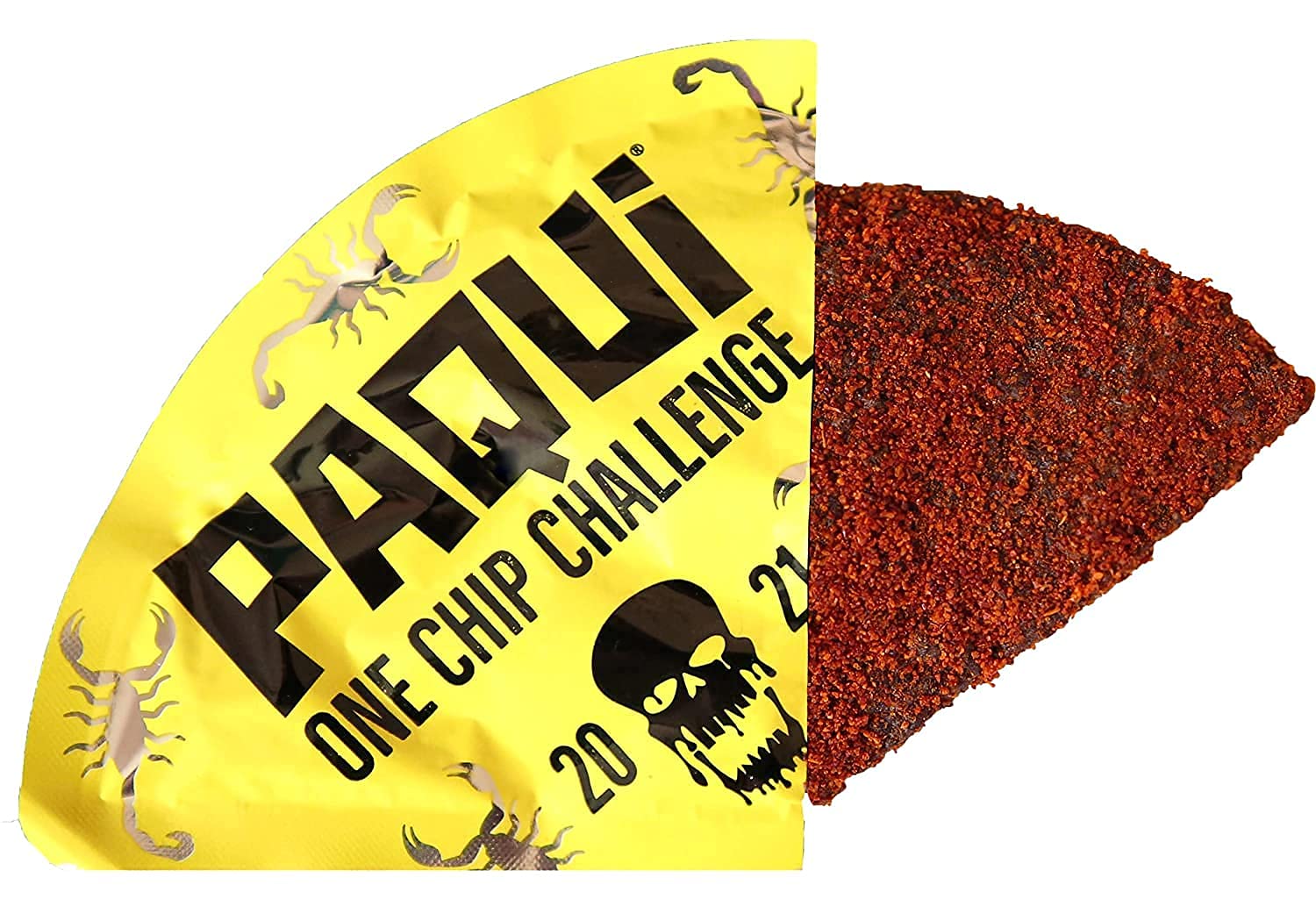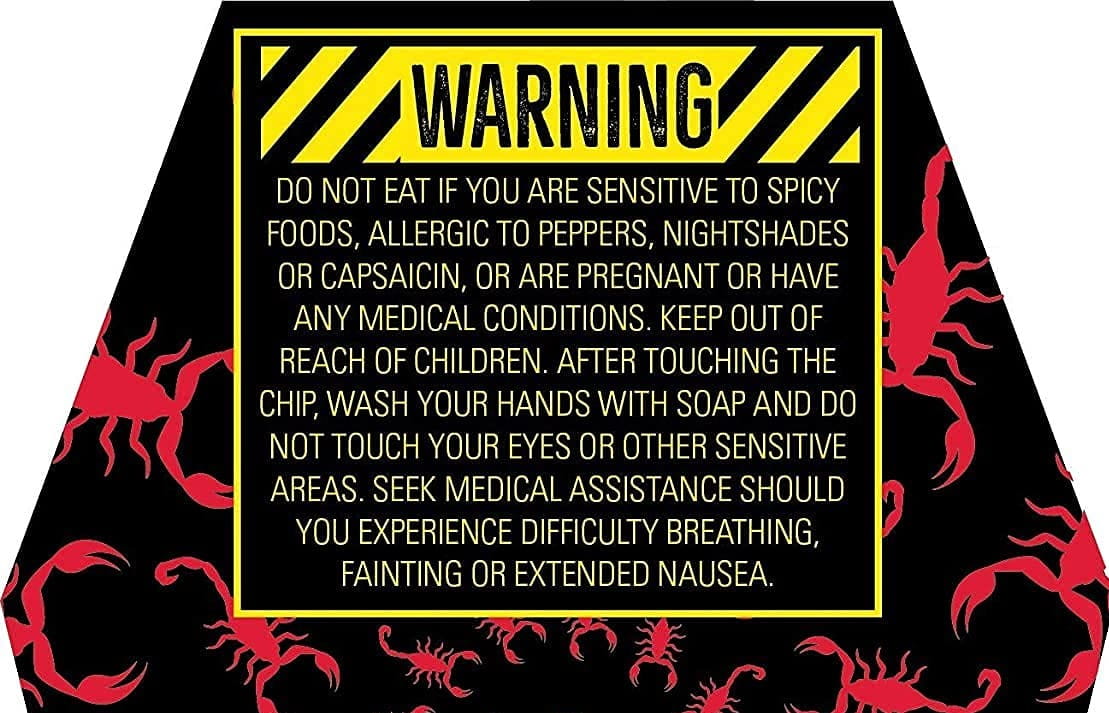Is the One Chip Challenge Dangerous?

The Bottom Line
The Paqui One Chip Challenge was a social media challenge that involved eating an extremely spicy tortilla chip. The chip contained capsaicin, a compound that causes mouth and throat pain, but which can also result in more serious health problems including trouble breathing, esophageal damage, and heart problems. The manufacturer started pulling the product from shelves in September 2023 following the death of a healthy teenager hours after participating in the challenge.

What was the Paqui One Chip Challenge?
The One Chip Challenge was a social media challenge promoted by Paqui, a tortilla chip company. Paqui sold packages containing one spicy chip and were labeled “One Chip Challenge.” The chips were flavored with Carolina Reaper and Naga Viper peppers. The challenge involved eating the single spicy tortilla chip, then waiting as long as possible before eating or drinking anything else. The Paqui website characterized those who could last a full hour without eating or drinking as “invincible” while people who would eat or drink a minute after eating the chip were dismissed as being “powerless.” Participants in this challenge were encouraged to post their reactions on social media.
How hot is the One Chip Challenge?
The hot or spicy sensation felt in the mouth and throat after eating chili peppers is due to the presence of capsaicin. The capsaicin content of foods is frequently assessed by using the Scoville heat units (SHU) scale. Bell peppers have zero SHU, while pure capsaicin is rated at approximately 15 million SHU. Carolina Reaper peppers rate up to 2.2 million SHU, and Naga Viper peppers rate approximately 1.4 million SHU. The high SHU measurements indicate that both of these peppers are quite pungent and irritating to taste.
What is capsaicin?
Capsaicin is a naturally occurring compound that is the active ingredient in chili peppers. Capsaicin might be used by pepper plants as a natural defense against predators and fungal species. Although it is found in nature, capsaicin can also be synthesized. It is available in powder, liquid, cream, and spray formulations. Capsaicin is colorless and odorless; it is highly pungent and irritating to the eyes, skin, and mouth of humans and animals.
What is capsaicin used for?
Capsaicin is a component of some pepper spray and bear spray products and is described as being more irritating than Mace. Capsaicin can affect pain perception in the human body, and repeated applications of capsaicin to the skin can reduce the sensation of pain. Topical capsaicin is available as an arthritis cream and is sometimes used as a treatment for cannabinoid hyperemesis syndrome, a disorder involving recurrent abdominal pain, nausea, and vomiting in people who regularly use cannabis.
What peppers were in the One Chip Challenge?
The spicy peppers included in the One Chip Challenge varied each year. In 2023, the chips contained Carolina Reaper and Naga Viper peppers. Previous years’ versions included Sichuan and Scorpion peppers in addition to the Carolina Reaper pepper.
How long does the One Chip Challenge last?
Because capsaicin is highly irritating, most people will develop immediate irritation of the mouth and throat after consuming capsaicin-containing products, such as the chip included in the Paqui One Chip Challenge. The irritating and painful signs and symptoms can last several hours but can persist for days in some people.
What do you eat after the One Chip Challenge?
Because of its chemical composition, milk might be more effective than water in relieving mouth and throat irritation after consumption of capsaicin-containing foods. Be sure to wash your hands thoroughly with soap and water after touching a One Chip Challenge chip or any other hot pepper product. Capsaicin can transfer from your hands to other parts of the body (such as the face and eyes) and cause additional irritation. If capsaicin gets in your eyes, immediately irrigate the eyes with room-temperature water for 15–20 minutes.
Was the One Chip Challenge safe?
People who eat capsaicin-containing products, including the tortilla chips featured in the Paqui One Chip Challenge, often experience mouth irritation, pain, or burning, along with intestinal discomfort. Capsaicin consumption can also cause more serious health problems, including shortness of breath, allergic reactions, chest pain, heart palpitations, and even heart attacks or strokes. Consumption of large amounts of capsaicin can also cause repeated vomiting that can lead to life-threatening esophageal damage. Because of this, people should use caution when consuming foods or products that contain capsaicin.
The One Chip Challenge was not suitable for children or teenagers, people who had food allergies, sensitivity to spicy foods, medical problems such as heart and lung disease, or who were pregnant. In September 2023, a 14-year-old boy died hours after taking the One Chip Challenge. This contributed to the discontinuation of One Chip Challenge production.
What if the One Chip Challenge makes me sick?
If you or someone else experiences worrisome symptoms after participating in the One Chip Challenge, get guidance from Poison Control immediately. Help from poison control is available online from webPOISONCONTROL and by phone at 1-800-222-1222. Both options are free, confidential, and available 24 hours a day.
Kelly Johnson-Arbor, MD and Maryann Amirshahi, MD
Medical Toxicologists at The National Capital Poison Center
Revised William G. Troutman, PharmD
Professor of Pharmacy Emeritus
Poison Control Media Information
Did you find this page helpful? If so, we need your support. Poison Control is in constant competition with misinformation online. Links to www.poison.org or our webPOISONCONTROL triage tool from other websites and blogs help internet searchers quickly find accurate information and Poison Control’s contact information in an emergency. If you use the content from this page, please provide attribution via a link back to this page, www.poison.org, or https://triage.webpoisoncontrol.org/#!/exclusions. By doing so, you could save a life. Thank you!
Poisoned?
Call 1-800-222-1222 or
Prevention Tips
- Keep capsaicin-containing products, including hot peppers and pepper spray, out of reach of children and pets.
- Wash hands thoroughly with soap and water after touching capsaicin-containing products.
- Use caution when participating in social media challenges such as the One Chip Challenge, as harmful or unexpected side effects can occur.
- Seek medical care immediately if you develop chest pain, difficulty breathing, severe headache, or other unexpected symptoms after consuming capsaicin.
This Really Happened
Case 1. A 15-year-old boy ate a Carolina reaper pepper on a dare. Two days later, he developed a severe headache and high blood pressure during football practice. He took acetaminophen (Tylenol) and went to an emergency room (ER) when the headache persisted. At the ER, he was initially diagnosed with a sinus infection and discharged home on antibiotics. The headache persisted over the next few days and remained severe, so he went back to the ER, where an MRI showed an abnormal narrowing of the arteries in his brain. He was diagnosed with reversible cerebral vasoconstriction related to hot pepper ingestion after additional testing failed to find another cause for his condition. He made a full recovery and was discharged from the hospital (from Taylor et al., 2020).
Case 2. A 25-year-old man developed severe chest pain 5 days after starting a new weight loss program that involved daily consumption of oral cayenne pepper pills. He went to an ER, where he was diagnosed with a heart attack believed to be related to his repeated ingestion of capsaicin-containing cayenne pepper. He was admitted to the hospital and treated with blood thinners, aspirin, and pain medications. Fortunately, he made a complete recovery, and had no further chest pain (from Sogut et al., 2012).
Case 3. A 14-year-old boy fainted at school shortly after participating in the One Chip Challenge and was taken to the school nurse. His mother picked him up from school, but he passed out again at home a few hours later. His family took him to an ER, where he was pronounced dead (from Edwards, 2023).
For More Information
Paqui.com refund Information. Accessed August 11, 2024.
Diaz A. Experts warn against the #OneChipChallenge allegedly sending kids to the hospital. New York Post. Updated September 20, 2022. Accessed August 11, 2024.
References
Poisoned?
Call 1-800-222-1222 or
Prevention Tips
- Keep capsaicin-containing products, including hot peppers and pepper spray, out of reach of children and pets.
- Wash hands thoroughly with soap and water after touching capsaicin-containing products.
- Use caution when participating in social media challenges such as the One Chip Challenge, as harmful or unexpected side effects can occur.
- Seek medical care immediately if you develop chest pain, difficulty breathing, severe headache, or other unexpected symptoms after consuming capsaicin.
This Really Happened
Case 1. A 15-year-old boy ate a Carolina reaper pepper on a dare. Two days later, he developed a severe headache and high blood pressure during football practice. He took acetaminophen (Tylenol) and went to an emergency room (ER) when the headache persisted. At the ER, he was initially diagnosed with a sinus infection and discharged home on antibiotics. The headache persisted over the next few days and remained severe, so he went back to the ER, where an MRI showed an abnormal narrowing of the arteries in his brain. He was diagnosed with reversible cerebral vasoconstriction related to hot pepper ingestion after additional testing failed to find another cause for his condition. He made a full recovery and was discharged from the hospital (from Taylor et al., 2020).
Case 2. A 25-year-old man developed severe chest pain 5 days after starting a new weight loss program that involved daily consumption of oral cayenne pepper pills. He went to an ER, where he was diagnosed with a heart attack believed to be related to his repeated ingestion of capsaicin-containing cayenne pepper. He was admitted to the hospital and treated with blood thinners, aspirin, and pain medications. Fortunately, he made a complete recovery, and had no further chest pain (from Sogut et al., 2012).
Case 3. A 14-year-old boy fainted at school shortly after participating in the One Chip Challenge and was taken to the school nurse. His mother picked him up from school, but he passed out again at home a few hours later. His family took him to an ER, where he was pronounced dead (from Edwards, 2023).
